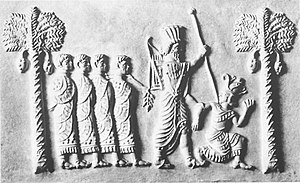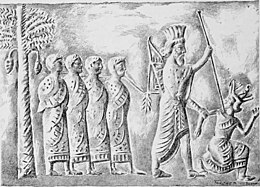| Zvenigorodsky seal | |
|---|---|
 Photograph of the seal (top), and drawing by Faucher-Gudin of the cylinder’s impression (bottom).[1] | |
 | |
| Material | Chalcedony |
| Size | 2.8 cm (1.1 in) x 1.2 cm (0.47 in) |
| Created | Late 5th–early 4th century BCE |
| Present location | Hermitage Museum |
| Identification | Гл-501 |
The Zvenigorodsky seal, sometimes dubbed "Persian king and the defeated enemies", is an Achaemenid cylinder seal made from chalcedony, and housed in the Hermitage Museum of Saint Petersburg, Russia (inv.no. Гл-501) since 1930, when it was acquired from a private collection.[2] It is the so-called "Zvenigorodsky seal", it was acquired in Kerch,[3] and first appears in the 1881 Compte rendu de la Commission Impériale Archéologique pour l'Année 1881.[4]
- ^ Maspero, Gaston (1903). History of Egypt, Chaldea, Syria, Babylonia and Assyria. Vol. 9. London: The Grolier Society., p. 166
- ^ Cylindrical seal. Persian King and the Defeated Enemies. Hermitage Museum
- ^ Strelkov, Alexander S. (1937). "The Moscow Artaxerxes Cylinder Seal". Bulletin of the American Institute for Iranian Art and Archaeology. 5 (1): 17–21. JSTOR 44243379.
- ^ Compte rendu de la Commission Impériale Archéologique pour l'Année 1881. 1881. pp. Plate V.